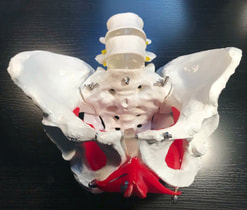Our first series of posts are introductory in nature and speak about three common pelvic floor-related issues. Future posts will delve deeper into injury prevention, recovering from acute and chronic pain, tips for exercise, and much much more! Some topics that will be covered shortly include: how to manage back pain, why your jaw might hurt, the best position to sit at your desk or take notes in class, and how to pick up your child from the floor. Do not be alarmed, as some topics you will read here are not dinner table talk, but I think they SHOULD be! Because for too long people, particularly women from conservative cultures, have been quiet (or suppressed) about their pelvic-related symptoms. However, pelvic floor physical therapists are here to break through those societal barriers and help people actually get the medical assistance that they need! This first post is a precursor to our pelvic series. Here, I answer two very important questions: What is the pelvic floor and why does it exist? Many are not aware of what exactly this term means and why some physical therapists specialize in the treatment of pelvic floor. So here we go! What is the pelvic floor? The pelvic floor is the region from your pubic bone to tailbone (from front to back) and from each sit bone (from side to side). YES! This encompasses your genitals and the areas that you poo and pee from! Everyone has a pelvic floor, no matter the gender that you identify with!
The pelvic floor consists of: Muscles. The muscles down there are just like your biceps and glutes, meaning you SHOULD have full control over them. You should be able to contract and relax these muscles at will. Try it! Imagine you are holding back your pee, and squeeze. What did you feel and where did you feel it? Bones. Put your hands on your hips (your ilium). Then walk your finger down from your belly button till you get to a hard bone (your pubis). Then take a seat with your hands under your butt and rock back and forth (your sit bones). Did you know that all of these bones are part of the same three sections of your pelvic girdle? Now put your finger in the center of your low back and walk your finger down to the top of your butt crack. This is your tailbone, and right above that is your sacrum. Nerves. Nerves provide sensation, tell to you when you need to use the bathroom, and help you control your muscles. The unconscious and conscious signals from your brain communicate to the rest of your body through these nerves. Imagine if the nerve that told you when to poop was not functioning properly. This happens and it can cause fecal incontinence, abdominal bloating, constipation, incomplete bowel emptying, diarrhea… you get the picture! Blood Vessels. We need blood to nourish muscles and organs and keep our tissues healthy. If there is congestion or lack of blood supply here, a host of issues can follow, including pain! Ligaments. Ligaments are like thin ropes that attach from bone to bone or organ to bone. Ligaments suspend everything into their appropriate place, like tent ropes. Fascia. Think of fascia like spider webs or saran wrap that encompasses everything mentioned above and holds it all together. Why does the pelvic floor exist? The pelvic floor has four main purposes:
I don’t think I need to explain why the first three are important. The 3-Part Pelvic Series blogs will go in depth into common issues people face with these. So let’s just talk about support for a moment. Your head, arms, trunk, and all the organs in your chest and abdomen lay on top of the pelvic floor. The term pelvic FLOOR is used because it literally is the base of support for so much of your body (we’ll give your feet credit in other posts). Do you remember the big “bounce houses” in kid’s birthday parties? Google it now if you don’t remember. The pelvic floor needs to support the weight and moving parts of everything above just like the bounce house supports a dozen jumping children. Soak in the importance of this! Last Thoughts. When there is dysfunction, pelvic floor physical therapy (PFPT) can help. Note that I am not referring to infections or inflammation, which should be consulted with your MD. Mechanical issues resulting from a trauma (falls or childbirth) or poor movement patterns (sitting on the toilet or squatting at the gym incorrectly) can be treated with PFPT. Chronic pain arising from unknown sources can also be treated by PFPT. Groin strain from skiing? PFPT to the rescue! Prolapse from your third child? PFPT to the rescue! So much of pelvic floor dysfunction can be addressed by receiving care from a physical therapist that specializes in the pelvic floor. More importantly, pelvic floor physical therapists look at your whole body to understand the sources of your issue, because everything is connected! If you don’t address the pelvic floor with your hip pain, you are missing a whole piece of the puzzle. Imagine if your doctor treated your shoulder but didn’t look an inch above at your neck to see if there was a related issue there. Hopefully reading this post has given you some insight into what the pelvic floor is and why it exists. There needs to be an incredible amount of flexibility AND strength here to create a healthy environment for these important areas. Stay tuned for more. Our 3-Part Pelvic Series is coming up next on Pooping, Peeing, and Procreating! Comments are closed.
|
Dr. GaziWelcome! Learn something of value, solve some of your problems, and feel a whole lot better with Sneha Physical Therapy's blog! Categories |
|
Sneha Physical Therapy
Copyright 2022 . All Rights Reserved .
Copyright 2022 . All Rights Reserved .


 RSS Feed
RSS Feed